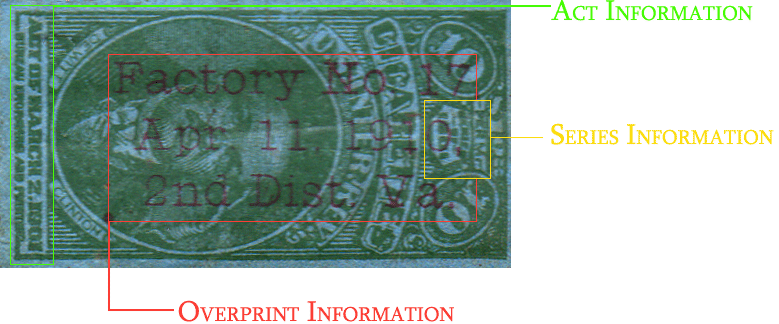
DATING INFORMATION
Home |
Research Center |
Cigarettes Boxes & Tobacco Packs |
For Sale |
Links |
Contact
DATING CIGARETTE PACKS
In order to properly date a cigarette pack to determine its relative year of manufacture, there are two main items on the package to examine:
1.) Revenue Stamps
2.) Manufacturer’s Notice
1.) Revenue Stamps
Revenue stamps, or tax stamps as they are more commonly referred to, are the best indicator of a cigarette pack’s year of manufacture or the range of years in which the pack was manufactured, if the tax stamp is still present on the outer packaging of the product.
Tax stamps were used on cigarette packages from approximately 1868 until 1959. Individual packs of cigarettes (as opposed to cartons) had tax stamps affixed to them beginning in 1879.
“Series of” Inscription
Starting in 1879 and lasting through 1917, tax stamps were printed with a “Series of” date on the surface of the tax stamp itself. These “Series of” dates are generally the first step in correctly dating the year or range of years of manufacture for the cigarette or tobacco pack. Below is a quick reference table that shows the “Series of” date and the corresponding range of years that “Series of” date was used on tax stamps.
Series of 1879: Appeared on tax stamps from 1879 through 1882.
Series of 1883: Appeared on tax stamps from 1883 through 1886.
Series of 1887: Appeared on tax stamps from 1887 through 1897.
Series of 1898: Appeared on tax stamps from 1898 through 1900.
Series of 1901: Appeared on tax stamps from 1901 through 1908.
Series of 1909: Appeared on tax stamps in 1909 only.
Series of 1910: Appeared on tax stamps from 1910 through 1916.
Series of 1917: Appeared on tax stamps from 1917 through 1920. – note: Series of 1917 tax stamps appearing on 10-cigarette count packs did not have a date on it but rather said “Ten” along the bottom border of the tax stamp.
From 1918 until 1931, tax stamps did not have a “Series of” date printed directly on the stamp, itself. Rather, overprints (as described below) were sometimes used. As a general rule of thumb, if a cigarette pack does not contain a “Series of” date or overprint, it will, in all likelihood, date from 1918-1931.
Overprints
Beginning in 1878, tax stamps sometimes were “overprinted” or “stamped” with a date and/or factory number. Unlike “Series of” printing which appeared directly on the tax stamp, the overprint was printed on top of the tax stamp and was not a part of the stamp itself. It was applied after-the-fact. Overprints are the single, most important tool available when dating a cigarette pack. If there is an overprint present, the year in which the pack was manufactured is instantly known. Unfortunately, however, not all cigarette packs contain overprints.
The image below is a close-up scan of a tax stamp detailing where both “Series of” dates and “overprints” are located on the stamp.

2.) Manufacturer’s Notice
Like tax stamps, a manufacturer’s notice was required on cigarette packages from 1868 until 1959. The requirement of a manufacturer’s notice was due largely in part to small cigarette producers collecting and reusing discarded cigarette packs and tax stamps (thereby not paying taxes on each new pack produced). Three different notices have been required by various changes in the law. Depending on the notice that appears on the cigarette pack, a date range of manufacture can be established. Unfortunately, during the years of baseball card production, only the second notice was used thereby invalidating the usefulness of manufacturer’s notices for dating cigarette packs. Below, however, is an overview of the three different manufacturer’s notices that will appear on the cigarette pack and the corresponding date range the notice was used
December 1869 – April 30, 1879: “Notice, the manufacturer of the cigarettes herein contained has complied with all of the requirements of law. Every person is cautioned under penalties of law, not to use this package for cigarettes again.”
May 1, 1879 – June 24, 1954: “The manufacturer of the cigarettes herein contained has complied with all of the requirements of law. Every person is cautioned not to use this package for cigarettes again, or the stamp thereon again, nor to remove the contents of this package without destroying said stamp, under penalties provided by law in such cases.”
June 25, 1954 – June 24, 1959: “Law forbids the reuse of the federal stamp hereon and requires the person who empties this package to destroy such stamp when the package is emptied.”
BACK TO RESEARCH CENTER |
CODE INFORMATION


